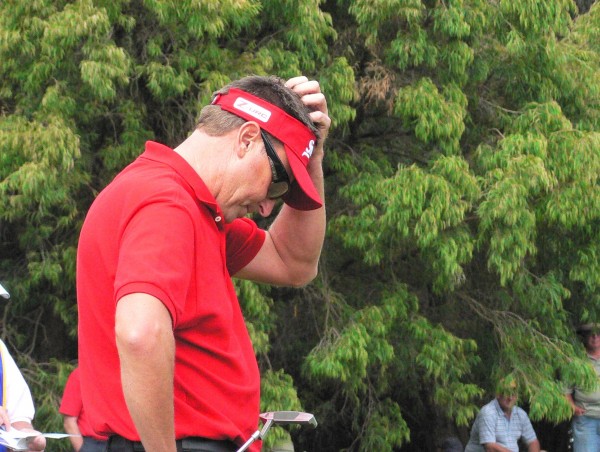
As fans of the game we often look to the headlines and leaderboards during the big tournaments to see what will happen next in golf. Who will win this Sunday? Will Tiger get closer to Jack Nicklaus’ 18 majors? Will Jason Day capture his first major championship? How many more majors will Phil Mickelson win before all is said and done?
Often lost in the shuffle is that even on the world’s most lucrative tour, many PGA Tour pros struggle with consistency and have to play their way out of slumps and overcome the mental obstacles of the game that challenge us all. And more often than not, a serious slump can put pressure on them to keep their Tour cards.
For us amateurs we all know what goes through our minds when we just can’t hit a fairway or sink a simple putt. We know what negative thoughts come to the forefront. But what do PGA Tour professionals think about when they’re going through a funk? Do they get more aggressive with their game to get out of it or do they play conservatively and just try to keep the ball in play? Does their approach change going into each round or their next shot? They are, after all, the best of the best but could they struggle with self-doubt and even self-pity?
The bottom line is that it is impossible to always play well. Even an accomplished player like Phil Mickelson will often miss cuts the week before a win. It’s simply not feasible to be on one’s game at all times.
“I’ve been a pro for 20 years now and you’re not going to have every part of your career and your season go rosy all the time,” Australian Greg Chalmers says. “You have to accept that there’s going to be an ebb and flow and hopefully when it starts to upswing you can take advantage of it.”
Although he has yet to win on the US Tour, Chalmers did harness his upswing of form during his 2011 campaign when he won both the Australian Open and the Australian PGA in dramatic fashion and against high quality fields.
Brendan Steele is a young American in his third year on Tour. Although he won relatively quickly during his rookie season at the 2011 Valero Texas Open he also agrees that dry spells and slumps are inevitable during any year in golf.
“The season is so long you’re going to have your ups and downs,” Steele says. “You just hope your downs aren’t that long and aren’t that down.”
Steele went through a major slump in 2013 missing six straight cuts during key events such as the Players Championship and US Open before finally righting the ship with a tie for thirteenth at the Travelers Championship.
So while in the midst of these slumps, does it affect the way players view their next round?
“It’s good to get a fresh start but it can be hard if it’s been going bad for a while,” Steele says. “As soon as something bad happens you kind of fall into the ‘oh no not again’ and that’s where you have to battle with it because it’s a new week and you have a new chance so you have to try to dig it out of that. But it’s easier said than done.”
Chalmers believes that keeping a positive approach to the next round in this context is one of the game’s greatest challenges.
“The hardest part is staying positive when all evidence is to the contrary,” Chalmers says.
Chalmers looks for simple things to find confidence in, like playing well in the week’s pro-am.
Tour Players understandably differ on whether they should be more aggressive or conservative when trying to play their way out of a bad stretch.
In the mind of 20-time PGA Tour winner Davis Love III, the conservative approach leads to more overall opportunities.
“I think the worse you’re playing the less chances that you can really take,” Love says. “You’ve just got to go back to hitting the middle of the fairway and the middle of the green and be patient. Sometimes that’s the hardest thing to do is to back off.”
During Love’s prime, the 49-year-old American was one of the longest hitters ranking 1st in driving distance on Tour in 1994, so backing off and taking less club off the tee must not have been an easy decision for him.
“If you feel like you have to make birdies, the way to make birdies is to give yourself a lot of birdie putts instead of a lot of putts for par,” Love says.
For others like Australian Nick O’Hern, there is no change in approaching shots during a funk.
“I approach every shot the same,” O’Hern says. “I just think of my routine, go through that, and if I execute that I’m going to hit a good shot. If you hit a poor shot it’s because you’ve somehow slipped up on your routine, that’s what I’ve found.”
Other players like Steele favour the aggressive approach and tempering that with having a positive attitude.
“I think you get too cautious a lot of the time,” Steele says. “You get out there trying to not make mistakes as opposed to just playing and thinking ‘I’m going to make mistakes today but a lot of things are going to go my way’.”
When bounces don’t go a player’s way it can be very frustrating for them as well. But even if you’re Rich Beem and you’ve beaten Tiger in his prime during a major, the 2002 USPGA at Hazeltine, you still have to deal with a negative thinking in a dry stretch.
“When you’re playing bad you’re just not seeing the good things happen,” Beem says. “You’re focusing on the bad things happening. When something that you perceive as bad happens, you go ‘here we go again’.”
Aussie Aaron Baddeley empathizes with that feeling as well. But he also adds that there’s ultimately not much difference in getting out of a slump versus staying caught in it.
“It’s a fine line,” Baddeley says. “You lip out a putt, you don’t get it up and down and miss the cut by a shot as opposed to making it and then you have a good weekend and all the sudden you’re over your funk.”
Baddeley struggled through a funk in 2013 on the PGA Tour that led to ten straight missed cuts, the worst slump of his eleven-year US Tour career. The fine line he speaks of is certainly evidenced by his missing the sixth of those ten cuts exactly on the number at the US Open at Merion.
“The easy thing to do is to start sulking,” Baddeley said of bad form. “But you’ve got to be patient, keep working towards something, finding the positives in everything.”
Once a round is completed it is very easy for players to wonder ‘what if’, but Stuart Appleby warns that you have to leave those sentiments and take a fresh start from one round to the next.
“You want to be intense and be physical with the game but once you’ve signed your card you have to absolutely throw everything away that might be baggage that happened during that day,” Appleby says. “Because, instinctually, as humans we tend to focus on the bad stuff.”
Sometimes these slumps are so pronounced and emotionally draining to players that they need some kind of escape or fresh start.
Players have their own unique ways of attaining a new perspective.
“If you can just take a step back and go home for a week or go something and not touch your golf clubs that’s probably as beneficial as anything just to clear your mind,” Beem says.
Steele chooses to give himself a pep talk in order to find a new start.
“Every round is a new round every shot is a new shot,” Steele says. “Just tell yourself that ‘my game is good it’s going to turn around’.”
Appleby—who had to use his one-time exemption for being in the top-50 in all-time money in order to play in 2013 after failing to qualify for his card—believes deep down that a year can simply turn around in one good week.
“It’s really about knowing that every single week you can go out and it’s another week,” said the nine-time US Tour winner. “It’s a new week. There’s always that one week which can turn it around. Those stories are so true.”
Appleby’s fortunes turned around with a tremendous week in 2010 at the Greenbrier Classic with an out-of-this-world 59 which led to his first win in over four years. Appleby had gone into the event having missed 13 cuts in the 23 events preceding.
Appleby is also quick to point out the importance of looking at struggles in context. Knowing that there is a bigger picture involved and that a player doesn’t need to stress out too much.
“If there was any advice I could give a young player it is to be competitive as much as you can but just know that you’ve got 20 years of this in the career at a world-class level,” Appleby says. “There’s no point busting your nut right now thinking it’s do or die on every shot.”
Robert Allenby subscribes to the philosophy of not worrying during such bad spells.
“Just don’t worry and stay as calm as can be,” Allenby says. “You can’t force something that’s just not there so it’s just important to just stay focused on whatever you want to be and what you’d like to achieve.”
Instead of looking toward the future and goals, Nick O’Hern deals with the stress of playing badly by looking more to the present moment. In other words, giving his undeterred best effort to the current shot.
“Every time you have negative thoughts you’re thinking about the future or the past,” O’Hern says. “You think about what’s going to happen or what I just did. If you’re in the moment, nothing’s negative about the moment. It is what it is. There’s no good, no bad, it’s just what is.”
Davis Love III takes a refreshingly positive perspective toward struggling on Tour. Perhaps that’s why he owns 20 victories in his career. He was never in a serious slump for too long.
“You always remember that the golf ball doesn’t know how you’ve been playing,” Love says. “If you just go out and play well you can turn it around real quick. It’s a strange game. It comes and goes that’s why overall you’ve just got to be very very even-keeled and patient and take the good with the bad.”
Overcoming the bad is rarely featured during golf tournament television coverage but it’s inevitable for many of these top players.




![Win the golfing experience of a lifetime, at the Hawai‘i International Week of Golf, valued at $6,900 [Winner Announced] Win the golfing experience of a lifetime, at the Hawai‘i International Week of Golf, valued at $6,900 [Winner Announced]](https://www.insidegolf.com.au/wp-content/uploads/Hawaii-Comp-500x294.jpg)